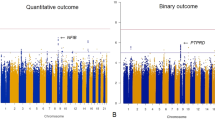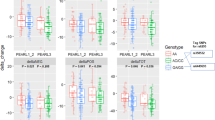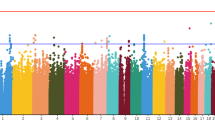Abstract
Little has been reported on the factors, genetic or other, that underlie the variability in individual response, particularly for autism. In this study we simultaneously explored the effects of multiple candidate genes on clinical improvement and occurrence of adverse drug reactions, in 45 autistic patients who received monotherapy with risperidone up to 1 year. Candidate genes involved in the pharmacokinetics (CYP2D6 and ABCB1) and pharmacodynamics (HTR2A, HTR2C, DRD2, DRD3, HTR6) of the drug, and the brain-derived neurotrophic factor (BDNF) gene, were analysed. Using the generalized estimating equation method these genes were tested for association with drug efficacy, assessed with the Autism Treatment Evaluation Checklist, and with safety and tolerability measures, such as prolactin levels, body mass index (BMI), waist circumference and neurological adverse effects, including extrapyramidal movements. Our results confirm that risperidone therapy was very effective in reducing some autism symptoms and caused few serious adverse effects. After adjusting for confounding factors, the HTR2A c.-1438G>A, DRD3 Ser9Gly, HTR2C c.995G>A and ABCB1 1236C>T polymorphisms were predictors for clinical improvement with risperidone therapy. The HTR2A c.-1438G>A, HTR2C c.68G>C (p.C33S), HTR6 c.7154–2542C>T and BDNF c.196G>A (p.V66M) polymorphisms influenced prolactin elevation. HTR2C c.68G>C and CYP2D6 polymorphisms were associated with risperidone-induced increase in BMI or waist circumference. We thus identified for the first time several genes implicated in risperidone efficacy and safety in autism patients. Although association results require replication, given the small sample size, the study makes a preliminary contribution to the personalized therapy of risperidone in autism.
This is a preview of subscription content, access via your institution
Access options
Subscribe to this journal
Receive 6 print issues and online access
$259.00 per year
only $43.17 per issue
Buy this article
- Purchase on Springer Link
- Instant access to full article PDF
Prices may be subject to local taxes which are calculated during checkout


Similar content being viewed by others
References
Francis K . Autism interventions: a critical update. Dev Med Child Neurol 2005; 47: 493–499.
Mandell DS, Morales KH, Marcus SC, Stahmer AC, Doshi J, Polsky DE . Psychotropic medication use among Medicaid-enrolled children with autism spectrum disorders. Pediatrics 2008; 121: 441–448.
Barnard L, Young AH, Pearson J, Geddes J, O’Brien G . A systematic review of the use of atypical antipsychotics in autism. J Psychopharmacol 2002; 16: 93–101.
West L, Waldrop J . Risperidone use in the treatment of behavioral symptoms in children with autism. Pediatr Nurs 2006; 32: 545–549.
McCracken JT, McGough J, Shah B, Cronin P, Hong D, Aman MG et al. Risperidone in children with autism and serious behavioral problems. N Engl J Med 2002; 347: 314–321.
McDougle CJ, Holmes JP, Carlson DC, Pelton GH, Cohen DJ, Price LH . A double-blind, placebo-controlled study of risperidone in adults with autistic disorder and other pervasive developmental disorders. Arch Gen Psychiatry 1998; 55: 633–641.
Shea S, Turgay A, Carroll A, Schulz M, Orlik H, Smith I et al. Risperidone in the treatment of disruptive behavioral symptoms in children with autistic and other pervasive developmental disorders. Pediatrics 2004; 114: e634–e641.
Jesner OS, Aref-Adib M, Coren E . Risperidone for autism spectrum disorder. Cochrane Database Syst Rev 2007; January 24: CD005040.
Correia C, Vicente A . Pharmacogenetics of risperidone response and induced side effects. Per Med 2007; 4: 271–293.
Boulton DW, DeVane CL, Liston HL, Markowitz JS . In vitro P-glycoprotein affinity for atypical and conventional antipsychotics. Life Sci 2002; 71: 163–169.
Scordo MG, Spina E, Facciola G, Avenoso A, Johansson I, Dahl ML . Cytochrome P450 2D6 genotype and steady state plasma levels of risperidone and 9-hydroxyrisperidone. Psychopharmacology (Berl) 1999; 147: 300–305.
Zanger UM, Raimundo S, Eichelbaum M . Cytochrome P450 2D6: overview and update on pharmacology, genetics, biochemistry. Naunyn Schmiedebergs Arch Pharmacol 2004; 369: 23–37.
Arnt J, Skarsfeldt T . Do novel antipsychotics have similar pharmacological characteristics? A review of the evidence. Neuropsychopharmacology 1998; 18: 63–101.
Tecott LH, Sun LM, Akana SF, Strack AM, Lowenstein DH, Dallman MF et al. Eating disorder and epilepsy in mice lacking 5-HT2c serotonin receptors. Nature 1995; 374: 542–546.
Ribases M, Gratacos M, Fernandez-Aranda F, Bellodi L, Boni C, Anderluh M et al. Association of BDNF with anorexia, bulimia and age of onset of weight loss in six European populations. Hum Mol Genet 2004; 13: 1205–1212.
Kernie SG, Liebl DJ, Parada LF . BDNF regulates eating behavior and locomotor activity in mice. EMBO J 2000; 19: 1290–1300.
Angelucci F, Mathe AA, Aloe L . Brain-derived neurotrophic factor and tyrosine kinase receptor TrkB in rat brain are significantly altered after haloperidol and risperidone administration. J Neurosci Res 2000; 60: 783–794.
Lane HY, Liu YC, Huang CL, Chang YC, Wu PL, Lu CT et al. Risperidone-related weight gain: genetic and nongenetic predictors. J Clin Psychopharmacol 2006; 26: 128–134.
Zhang XY, Zhou DF, Wu GY, Cao LY, Tan YL, Haile CN et al. BDNF levels and genotype are associated with antipsychotic-induced weight gain in patients with chronic schizophrenia. Neuropsychopharmacology 2008; 33: 2200–2205.
Rimland B, Edelson SM (2000). Autism Treatment Evaluation Checklist (ATEC), Autism Research Institute, San Diego, USA.
Rojahn J, Matson JL, Lott D, Esbensen AJ, Smalls Y . The Behavior Problem Inventory: an instrument for the assessment of self-injury, stereotyped behavior, and agression/destruction in individuals with developmental disabilities. J Autism Dev Disord 2001; 31: 577–588.
Tassé MJ, Aman MG, Hammer D, Rojahn J . The nisonger child behavior rating form: age and gender effects and norms. Res Dev Disabil 1996; 17: 59–75.
Lonsdale D, Shamberger RJ, Audhya T . Treatment of autism spectrum children with thiamine tetrahydrofurfuryl disulfide: a pilot study. Neuro Endocrinol Lett 2002; 23: 303–308.
Ratliff-Schaub K, Carey T, Reeves GD, Rogers MA . Randomized controlled trial of transdermal secretin on behavior of children with autism. Autism 2005; 9: 256–265.
Correia C, Santos P, Coutinho AM, Vicente AM . Characterization of pharmacogenetically relevant CYP2D6 and ABCB1 gene polymorphisms in a Portuguese population sample. Cell Biochem Funct 2009; 27: 251–255.
Hinney A, Ziegler A, Nothen MM, Remschmidt H, Hebebrand J . 5-HT2A receptor gene polymorphisms, anorexia nervosa, and obesity. Lancet 1997; 350: 1324–1325.
Zeger SL, Liang KY, Albert PS . Models for longitudinal data: a generalized estimating equation approach. Biometrics 1988; 44: 1049–1060.
de Leon J, Susce MT, Pan RM, Wedlund PJ, Orrego ML, Diaz FJ . A study of genetic (CYP2D6 and ABCB1) and environmental (drug inhibitors and inducers) variables that may influence plasma risperidone levels. Pharmacopsychiatry 2007; 40: 93–102.
Pandina GJ, Aman MG, Findling RL . Risperidone in the management of disruptive behavior disorders. J Child Adolesc Psychopharmacol 2006; 16: 379–392.
Malone RP, Maislin G, Choudhury MS, Gifford C, Delaney MA . Risperidone treatment in children and adolescents with autism: short- and long-term safety and effectiveness. J Am Acad Child Adolesc Psychiatry 2002; 41: 140–147.
Martin A, Scahill L, Anderson GM, Aman M, Arnold LE, McCracken J et al. Weight and leptin changes among risperidone-treated youths with autism: 6-month prospective data. Am J Psychiatry 2004; 161: 1125–1127.
Turgay A, Binder C, Snyder R, Fisman S . Long-term safety and efficacy of risperidone for the treatment of disruptive behavior disorders in children with subaverage IQs. Pediatrics 2002; 111: 34.
Anderson GM, Scahill L, McCracken JT, McDougle CJ, Aman MG, Tierney E et al. Effects of short- and long-term risperidone treatment on prolactin levels in children with autism. Biol Psychiatry 2007; 61: 545–550.
Findling RL, Kusumakar V, Daneman D, Moshang T, De Smedt G, Binder C . Prolactin levels during long-term risperidone treatment in children and adolescents. J Clin Psychiatry 2003; 64: 1362–1369.
Ellingrod VL, Lund BC, Miller D, Fleming F, Perry P, Holman TL et al. 5-HT2A receptor promoter polymorphism, -1438G/A and negative symptom response to olanzapine in schizophrenia. Psychopharmacol Bull 2003; 37: 109–112.
Herken H, Erdal ME, Esgi K, Virit O, Aynacioglu AS . The relationship between the response to risperidone treatment and 5-HT2A receptor gene (T102C and 1438G/A) polymorphism in schizophrenia. Bull Clin Psychopharmacol 2003; 13: 161–166.
Myers RL, Airey DC, Manier DH, Shelton RC, Sanders-Bush E . Polymorphisms in the regulatory region of the human serotonin 5-HT2A receptor gene (HTR2A) influence gene expression. Biol Psychiatry 2007; 61: 167–173.
Parsons MJ, D’Souza UM, Arranz MJ, Kerwin RW, Makoff AJ . The -1438A/G polymorphism in the 5-hydroxytryptamine type 2A receptor gene affects promoter activity. Biol Psychiatry 2004; 56: 406–410.
Arranz MJ, Munro J, Sham P, Kirov G, Murray RM, Collier DA et al. Meta-analysis of studies on genetic variation in 5-HT2A receptors and clozapine response. Schizophr Res 1998; 32: 93–99.
Cascorbi I . Role of pharmacogenetics of ATP-binding cassette transporters in the pharmacokinetics of drugs. Pharmacol Ther 2006; 112: 457–473.
Xing Q, Gao R, Li H, Feng G, Xu M, Duan S et al. Polymorphisms of the ABCB1 gene are associated with the therapeutic response to risperidone in Chinese schizophrenia patients. Pharmacogenomics 2006; 7: 987–993.
Salama NN, Yang Z, Bui T, Ho RJ . MDR1 haplotypes significantly minimize intracellular uptake and transcellular P-gp substrate transport in recombinant LLC-PK1 cells. J Pharm Sci 2006; 95: 2293–2308.
Aarnoudse AJ, Dieleman JP, Visser LE, Arp PP, van der Heiden IP, van Schaik RH et al. Common ATP-binding cassette B1 variants are associated with increased digoxin serum concentration. Pharmacogenet Genomics 2008; 18: 299–305.
Mathijssen RH, Marsh S, Karlsson MO, Xie R, Baker SD, Verweij J et al. Irinotecan pathway genotype analysis to predict pharmacokinetics. Clin Cancer Res 2003; 9: 3246–3253.
Bozina N, Kuzman MR, Medved V, Jovanovic N, Sertic J, Hotujac L . Associations between MDR1 gene polymorphisms and schizophrenia and therapeutic response to olanzapine in female schizophrenic patients. J Psychiatr Res 2008; 42: 89–97.
Lin YC, Ellingrod VL, Bishop JR, Miller del D . The relationship between P-glycoprotein (PGP) polymorphisms and response to olanzapine treatment in schizophrenia. Ther Drug Monit 2006; 28: 668–672.
Alenius M, Wadelius M, Dahl ML, Hartvig P, Lindstrom L, Hammarlund-Udenaes M . Gene polymorphism influencing treatment response in psychotic patients in a naturalistic setting. J Psychiatr Res 2008; 42: 884–893.
Lane HY, Hsu SK, Liu YC, Chang YC, Huang CH, Chang WH . Dopamine D3 receptor Ser9Gly polymorphism and risperidone response. J Clin Psychopharmacol 2005; 25: 6–11.
Reynolds GP, Yao Z, Zhang X, Sun J, Zhang Z . Pharmacogenetics of treatment in first-episode schizophrenia: D3 and 5-HT2C receptor polymorphisms separately associate with positive and negative symptom response. Eur Neuropsychopharmacol 2005; 15: 143–151.
Szekeres G, Keri S, Juhasz A, Rimanoczy A, Szendi I, Czimmer C et al. Role of dopamine D3 receptor (DRD3) and dopamine transporter (DAT) polymorphism in cognitive dysfunctions and therapeutic response to atypical antipsychotics in patients with schizophrenia. Am J Med Genet B Neuropsychiatr Genet 2004; 124B: 1–5.
Buckland PR, Hoogendoorn B, Guy CA, Smith SK, Coleman SL, O’Donovan MC . Low gene expression conferred by association of an allele of the 5-HT2C receptor gene with antipsychotic-induced weight gain. Am J Psychiatry 2005; 162: 613–615.
Richelson E, Souder T . Binding of antipsychotic drugs to human brain receptors focus on newer generation compounds. Life Sci 2000; 68: 29–39.
Reynolds GP, Zhang ZJ, Zhang XB . Association of antipsychotic drug-induced weight gain with a 5-HT2C receptor gene polymorphism. Lancet 2002; 359: 2086–2087.
Ryu S, Cho EY, Park T, Oh S, Jang WS, Kim SK et al. 759 C/T polymorphism of 5-HT2C receptor gene and early phase weight gain associated with antipsychotic drug treatment. Prog Neuropsychopharmacol Biol Psychiatry 2007; 31: 673–677.
Zhang Z, Zhang X, Yao Z, Chen J, Sun J, Yao H et al. Association of antipsychotic agent-induced weight gain with a polymorphism of the promotor region of the 5-HT2C receptor gene]. Zhonghua Yi Xue Za Zhi 2002; 82: 1097–1101.
Torre DL, Falorni A . Pharmacological causes of hyperprolactinemia. Ther Clin Risk Manag 2007; 3: 929–951.
Van de Kar LD, Javed A, Zhang Y, Serres F, Raap DK, Gray TS . 5-HT2A receptors stimulate ACTH, corticosterone, oxytocin, renin, and prolactin release and activate hypothalamic CRF and oxytocin-expressing cells. J Neurosci 2001; 21: 3572–3579.
Lacau-Mengido IM, Libertun C, Becu-Villalobos D . Different serotonin receptor types participate in 5-hydroxytryptophan-induced gonadotropins and prolactin release in the female infantile rat. Neuroendocrinology 1996; 63: 415–421.
Young RM, Lawford BR, Barnes M, Burton SC, Ritchie T, Ward WK et al. Prolactin levels in antipsychotic treatment of patients with schizophrenia carrying the DRD2*A1 allele. Br J Psychiatry 2004; 185: 147–151.
Yasui-Furukori N, Saito M, Tsuchimine S, Nakagami T, Sato Y, Sugawara N et al. Association between dopamine-related polymorphisms and plasma concentrations of prolactin during risperidone treatment in schizophrenic patients. Prog Neuropsychopharmacol Biol Psychiatry 2008; 32: 1491–1495.
Mattson MP, Maudsley S, Martin B . BDNF and 5-HT: a dynamic duo in age-related neuronal plasticity and neurodegenerative disorders. Trends Neurosci 2004; 27: 589–594.
Tarazi FI, Zhang K, Baldessarini RJ . Long-term effects of olanzapine, risperidone, and quetiapine on serotonin 1A, 2A and 2C receptors in rat forebrain regions. Psychopharmacology (Berl) 2002; 161: 263–270.
Acknowledgements
We thank the autism patients and their families for their collaboration in this study. We thank Paulo Nogueira and Dr Valeska Andreozzi for their help and collaboration in the statistical analysis. This work was supported by grants from Fundação para a Ciência e a Tecnologia (FCT) (POCTI/FCB/44706/2002). C Correia is supported by a fellowship from the Fundação para a Ciência e Tecnologia.
Author information
Authors and Affiliations
Corresponding author
Ethics declarations
Competing interests
The authors declare no conflict of interest.
Additional information
Supplementary Information accompanies the paper on the The Pharmacogenomics Journal website
Supplementary information
Rights and permissions
About this article
Cite this article
Correia, C., Almeida, J., Santos, P. et al. Pharmacogenetics of risperidone therapy in autism: association analysis of eight candidate genes with drug efficacy and adverse drug reactions. Pharmacogenomics J 10, 418–430 (2010). https://doi.org/10.1038/tpj.2009.63
Received:
Revised:
Accepted:
Published:
Issue Date:
DOI: https://doi.org/10.1038/tpj.2009.63
Keywords
This article is cited by
-
A systematic review of the effects of CYP2D6 phenotypes on risperidone treatment in children and adolescents
Child and Adolescent Psychiatry and Mental Health (2018)
-
Bridging Autism Spectrum Disorders and Schizophrenia through inflammation and biomarkers - pre-clinical and clinical investigations
Journal of Neuroinflammation (2017)
-
Autism genetics: opportunities and challenges for clinical translation
Nature Reviews Genetics (2017)
-
Prescription trends in children with pervasive developmental disorders: a claims data-based study in Japan
World Journal of Pediatrics (2016)
-
Pharmacogenomic Medicine in Autism: Challenges and Opportunities
Pediatric Drugs (2015)



